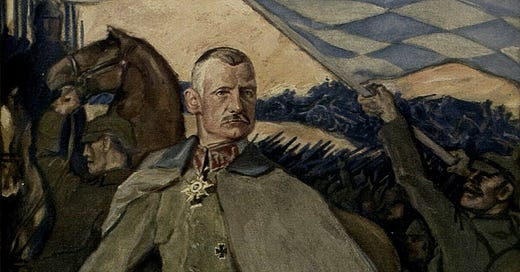This post belongs to a long series. To read the parts that precede it, and those that follow, please use the following display link.
Field Marshal Count Moltke, Count Schlieffen, and the World War
Georg Wetzell
(Continued)
This battle probably would have gone under way on August 20, along the entire front from Maubeuge, through Namur, Luxemburg, Metz to Saarburg. Judging by the geo-strategic situation, the battle was certain to dissolve itself into partial operations, of which Count Schlieffen says that 'they enable the commander to gain the great objective of defeating the hostile main forces'.
The main effort, both in Lorraine and on the front between the Meuse and Moselle, thus would have been shifted to the western flank. The objective of the operation in Lorraine has already been mentioned: the defeat of one-half of the French forces, by isolating and driving them into Alsace. The objective of the operation in the Ardennes is quite similar; the German forces of the right flank should have attacked the other half of the French armies that were invading Belgium, and driven them along the Meuse into Lorraine and against the fortified line of the Moselle River-Metz-Diedenhofen.
Joffre counted on such a German attack and had planned to meet it by a counteroffensive. With the change in the hostile situation, the Belgian theatre of operations west of the Meuse than would have lost its great strategic importance. Actual warfare admits of no carefully planned strategic envelopments which take up much time.
In order to accomplish great results speedily, the operations must be readily adapted to the hostile situation, and all vulnerable points of the enemy must be exploited as soon as they are recognized. The extremely critical situation on the Eastern Front, 1914, made this especially mandatory for the German High Command while waging a war on several fronts. General von Moltke (the Younger) hoped to gain this decision in the Battle of the Frontiers on the Western Front.
In marching on Maubeuge, the right flank of the German armies should have attacked and defeated all French and British forces that were operating in the country west of the Meuse. Eleven German corps would have sufficed to accomplish this, considering the hostile disposition as then known to the German High Command.
The basic instructions could have been issued by telephone and telegraph 'from a desk far in the rear'. However, their execution required more than the commander at his desk near the telephone. (Even under modern conditions, hostile interference with telegraph and radio communication must be expected.)
The Chief of Staff (General von Moltke) should have gone to Saarbrücken on August 17 and remained there for at least a day or two; there he should have clearly explained his strategic intentions to the responsible commanders and assured the harmonious conduct of the operations of the three armies under the command of the Crown Prince of Bavaria (Sixth Army) as contemplated.
Incidentally, G. H. Q. officers should have been sent to the front, in order to supervise personally the disposition of the three armies for battle from August 17 on. If the strategic measures indicated in the accompanying sketches had been taken, a far-reaching decision could have been expected within eight days.
To be continued …







